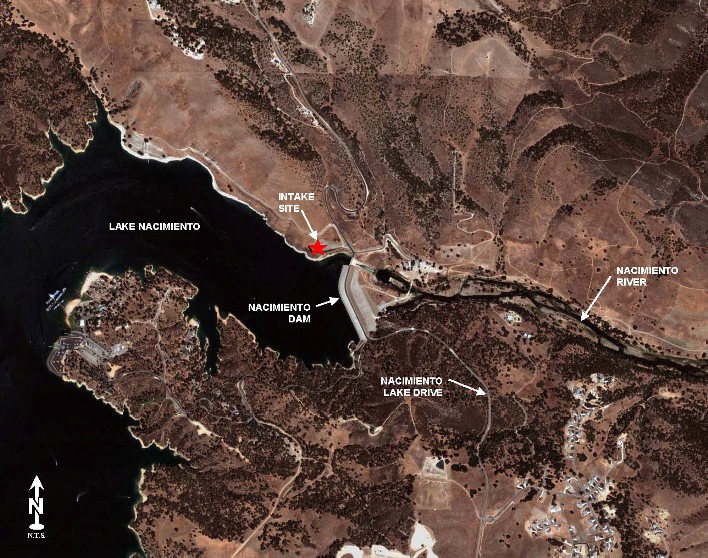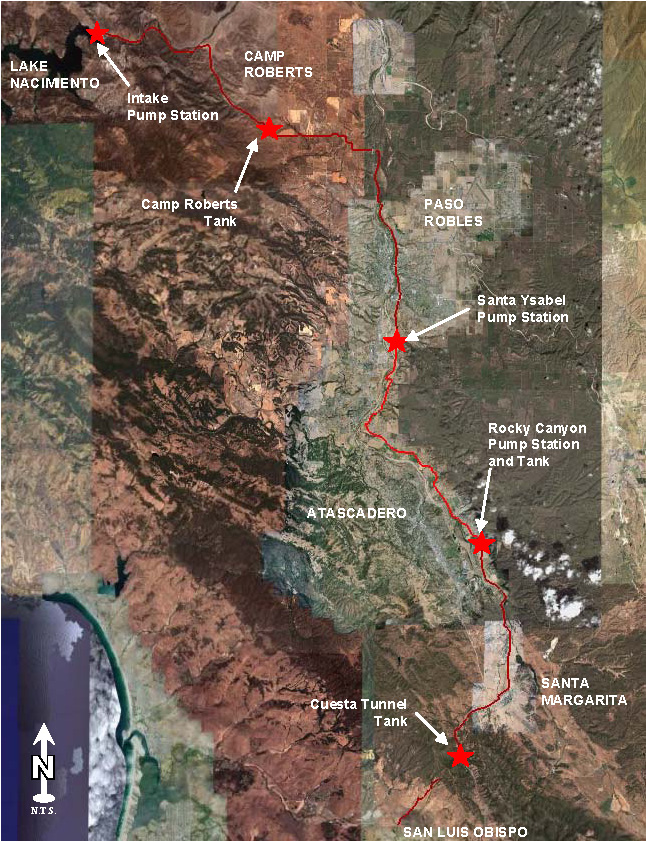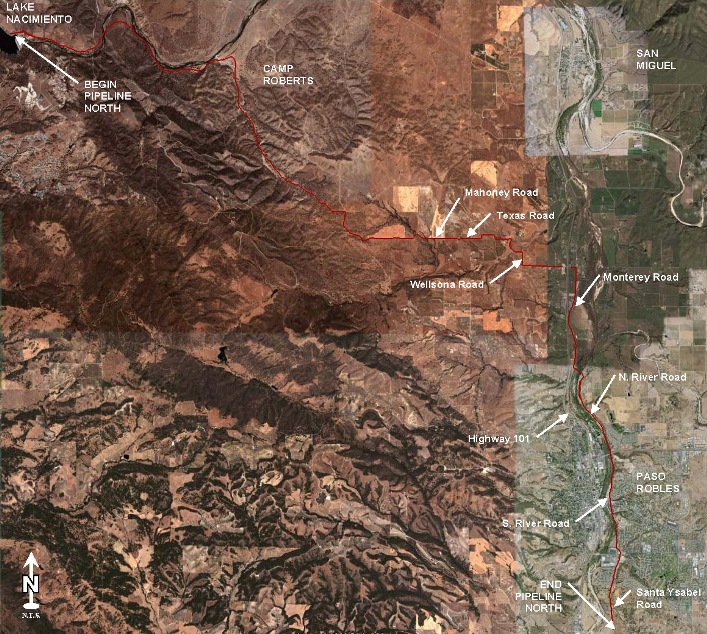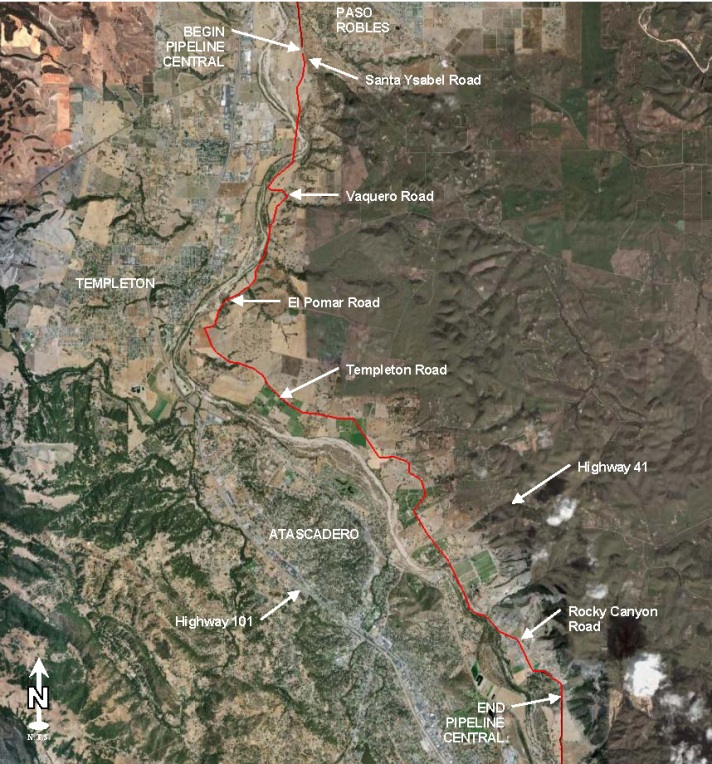Nacimiento Water Project
One of the largest value projects the County has ever completed, the Nacimiento Water Project began operations in 2011 after the construction of the $176 million, 45-mile pipeline from Lake Nacimiento to San Luis Obispo was completed. Today County staff oversee the operations and management of the pipeline.
Project Background
In 1959, San Luis Obispo County secured the rights to 17,500 acre-feet of water per year from Lake Nacimiento. At the time of construction in 2007 the Nacimiento Water Project (Project) was the single largest project that San Luis Obispo County had ever undertaken. The total cost of the project, including design, construction, environmental permitting, and right-of-way, was $176 million.
Project Description
This regional Project consists of a multi-port sloping intake facility at Lake Nacimiento with a pump station, two intermediate pump stations, three storage tanks, a control system, and approximately 45 miles of transmission pipeline ranging from 36- to 12-inches in diameter, with the ability to deliver 15,750 acre-feet of raw water each year to communities within San Luis Obispo County.
The $176.1-million Project is owned, managed and operated by the San Luis Obispo County Flood Control and Water Conservation District (District). It is the District's largest project ever constructed by a factor of six, and serves as an icon of collaboration between communities within San Luis Obispo County. The Participants in the Project are the City of Paso Robles, Templeton Community Services District, Atascadero Mutual Water Company, the City of San Luis Obispo, and Community Services Area 10, Benefit Zone A.
The Board of Supervisors took action to award Specs 01, 03, 04, 05 on August 28, 2007 and Spec 02 on September 11, 2007. Notices to Proceed were issued on October 2007, allowing construction to begin.
The Project began operations on January 7, 2011.

Nacimiento Specs
Intake Photos
Intake Description
The Nacimiento Water Project Intake facility is located at Lake Nacimiento, just north of the Nacimiento Dam spillway, in north San Luis Obispo County. Its purpose is to draw high quality water from Lake Nacimiento for delivery to the Project’s participating communities. The Intake consists of four main aspects:
- Intake Shaft: A 180-foot deep, 20-foot diameter vertical shaft and wetwell was constructed at the Intake site to collect water pumped through the Project’s pipeline. Shaft work included shaft excavation, design and construction of an initial shaft support system, ground water control, grouting, and construction of the final shaft lining.
- Intake Tunnel: A 500-foot long, 48-inch minimum diameter tunnel connects the bottom of the shaft to the intake pipe. Tunnel work was performed via microtunneling and a "hot-tap" - one of the few performed to-date.
- Intake Pipe: An intake pipe connects to the Intake tunnel and to slope up the lake bottom. The pipe draws water via seven ports with hydraulic pressure system actuating valves and fish screens,which was installed along the Intake pipe at various depths of the reservoir for optimal quality control. The Intake pipe construction required marine and diving operations to perform underwater excavation, to construct pipe supports, and to install the intake pipe.
- Log Boom: The old log boom that provided a safety buffer around the Nacimiento Dam was removed and replaced with a new log boom to protect the new Intake facilities and to eliminate recreational body contact with the water within 500 feet of the Intake pipe.
Intake Aerial Map

Facilities Description
The Nacimiento Water Project Facilities (Facilities) are located on five main sites along the Project’s 45-mile pipeline. The ultimate purpose of the Facilities is to maintain water pressure within the Project’s pipeline and to ensure efficient delivery of raw water from Lake Nacimiento to the Project’s participants. The Facilities consist of three main parts:
- Pump Stations: Three pump stations – Intake, Santa Ysabel, and Rocky Canyon Pump Stations – maintain adequate water pressure for the transmission of water to all Project participants along the pipeline alignment. The Intake Pump Station is located at Lake Nacimiento over the top of the Intake shaft,and contains five, 500 horsepower pumps. The Santa Ysabel Pump Station is located near the south side of Paso Robles on Santa Ysabel Road,and contains of four, 600 horsepower pumps. The Rocky Canyon Pump Station is located near the southeast side of Atascadero on Rocky Canyon Road,and contains of three 400 horsepower pumps.
The pump station construction work included: construction of access roads; construction of pump station buildings, including installation of plumbing, HVAC systems, electrical transformers and metering, electrical equipment, lighting, grounding, conduit and cable; construction of short stretches of pipeline; installation of pumps and valves; construction of surge control facilities; installation of instrumentation and controls and flow metering; installation of a fiber optic communication network; and installation of corrosion control, and appurtenant works. - Storage Tanks: Three storage tanks – Camp Roberts, Rocky Canyon, and Cuesta Tunnel Tanks– provide water storage and conserve pump energy needed to deliver water. The Camp Roberts Tank, located on Camp Roberts,has storage capacity of 850,000 gallons. The Rocky Canyon Tank, located near the southeast side of Atascadero on Rocky Canyon Road (the same site as Rocky Canyon Pump Station), has a storage capacity of 850,000 gallons. The Cuesta Tunnel Tank, located off Highway 101at the top of Cuesta Grade,has a storage capacity of 300,000gallons.
Tank construction work included: excavation, foundation preparation, and slope protection; reinforced concrete tank foundation; site improvements, drainage facilities, and access road paving; construction of inlet and outlet piping, valves, and appurtenances; welded steel tank design, fabrication and field erection; application and curing of tank coatings; and installation of cathodic protection and instrumentation and control systems. - Supervisory Control and Data Acquisition (SCADA): A SCADA system and Project controls electronically control the completed Project. This work included installation of SCADA equipment, software, electrical conduit, cable, and system configuration services.
Facilities Aerial Map

Pipeline North Photos
Pipeline North Description
The Nacimiento Water Project Pipeline North is the northern portion of the transmission line that delivers raw water from Lake Nacimiento to the Project’s participants. Its alignment commences at the Intake Pump Station at Lake Nacimiento, continues through Camp Roberts and Paso Robles and ends just south of Paso Robles at the Paso Robles Turnout on Santa Ysabel Road. The Pipeline North consists of three main parts:
- Pipeline: Approximately 22 miles of 36-inch to 30-inch diameter steel pipeline was installed as the northern portion of the Project’s pipeline. Pipeline work included trenching, pipeline installation, and backfilling; sheeting, shoring and bracing; performance of trenchless construction at road and highway crossings; application of pipeline linings and coatings; installation of appurtenances and corrosion monitoring stations; pavement restoration; traffic and pedestrian control; protection and location of existing utilities; performance of pipeline pressure and leakage testing; unexploded ordinance (UXO) detection and avoidance on Camp Roberts; hazardous materials removal and disposal; and site restoration.
- Horizontal Directional Drilling (HDD): Two HDD river crossings were performed: one beneath the Nacimiento River on Camp Roberts, having an approximate length of 1750-feet and a minimum depth of 40-feet; and one beneath the Salinas River, just north of Paso Robles, near the intersection of Monterey Road and Highway 101, having an approximate length of 1,260-feet and an approximate depth of 42-feet.
- Fiber Optic Cable: A fiber optic communication line aids in Project operations and control. The contractor installed pull boxes and installed and tested of fiber optic conduit and cable.
Pipeline North Aerial Map

Pipeline Central Photos
Pipeline Central Description
The Nacimiento Water Project Pipeline Central is the central portion of the transmission line that delivers raw water from Lake Nacimiento to the Project’s participants. Its alignment commences just south of Paso Robles at the Paso Robles Turnout on Santa Ysabel Road, continues south through Templeton and the east side of Atascadero and ends at the Rocky Canyon Tank and Pump Station in south Atascadero on Rocky Canyon Road. The Pipeline Central consists of five main parts:
- Pipeline: Approximately 11 miles of 24-inch to 18-inch diameter ductile iron pipeline was installed as the central portion of the Project’s pipeline. Pipeline work included trenching, pipeline installation, and backfilling; sheeting, shoring and bracing; performance of trenchless construction at road and highway crossings; application of pipeline linings and coatings; installation of appurtenances and corrosion monitoring stations; pavement restoration; traffic and pedestrian control; protection and location of existing utilities; hazardous materials removal and disposal; and site restoration.
- Turnouts: Three turnouts deliver water from the Project’s main pipeline to to the City of Paso Robles, Templeton Community Services District (TCSD), Atascadero Mutual Water Company (AMWC). The Paso Robles Turnout is located just south of Paso Robles on Santa Ysabel Road and consists of approximately 3,100-feet of 24-inch diameter ductile iron and welded steel pipeline with one horizontal directional drilling (HDD) river crossing. The TCSD Turnout is located in Templeton off of Templeton Road and consists of approximately 3,950-feet of 8-inch diameter ductile iron and welded steel pipeline with one HDD river crossing. The AMWC Turnout is located just northeast of Atascadero off of Templeton Road and consists of approximately 2,300-feet of 18-inch diameter ductile iron and welded steel pipeline with one HDD river crossing. Construction consisted of turnout facility construction, including installation of flow meters, isolation valves, flow control valves, and electrical and instrumentation and control systems.
- Horizontal Directional Drilling (HDD): Four HDD river crossings were performed beneath the Salinas River: one located at the Paso Robles Turnout, having an approximate length of 1,930-feet and an approximate depth of 94-feet; one located just south of Santa Ysabel Road, having an approximate length of 3,000-feet and an approximate depth of 167-feet; one located at the TCSD Turnout, having an approximate length of 860-feet and an approximate depth of 45-feet; and one located at the AMWC Turnout, having an approximate length of 1,060-feet and an approximate depth of 52-feet.
- Fiber Optic Cable: A fiber optic communication line aids in Project operations and control. The contractor installed pull boxes and installed and tested of fiber optic conduit and cable.
- Templeton Road Realignment: An approximate half-mile stretch of the northern portion of Templeton Road was realigned to improve traffic safety. This work included demolition, grading, paving, and utility relocation.
Pipeline Central Aerial Map

Pipeline South Photos
Pipeline South Description
The Nacimiento Water Project Pipeline South is the southern portion of the transmission line delivers raw water from Lake Nacimiento to the Project’s participants. Its alignment commences at the Rocky Canyon Tank and Pump Station in south Atascadero on Rocky Canyon Road, continues south through Santa Margarita and the Cuesta Tunnel (at the top of Cuesta Grade), and ends just north of San Luis Obispo at the San Luis Obispo Turnout on Stenner Creek Road. The Pipeline South consists of three main parts:
- Pipeline: Approximately 12 miles of 18-inch to 12-inch diameter ductile iron pipeline were installed as the southern portion of the Project’s pipeline. Pipeline work included trenching, pipeline installation, and backfilling; sheeting, shoring and bracing; performance of trenchless construction at road and highway crossings; application of pipeline linings and coatings; installation of appurtenances and corrosion monitoring stations; pavement restoration; traffic and pedestrian control; protection and location of existing utilities; hazardous materials removal and disposal; and site restoration.
- Turnouts: One turnout delivers water from the Project’s main pipeline to the City of San Luis Obispo and CSA-10A. The San Luis Obispo Turnout is located on the north side of San Luis Obispo off of Stenner Creek Road and consists of approximately 305-feet of 12-inch diameter welded steel pipeline and a turnout facility. Turnout facility work included installation of flow meters, isolation valves, flow control valves, and electrical and instrumentation and control systems.
- Fiber Optic Cable: A fiber optic communication line aids in Project operations and control. The contractor installed pull boxes and installed and tested of fiber optic conduit and cable.
Pipeline South Aerial Map

Project Contacts
For more information please contact Anna McKenna via email or phone: (805) 781-1521, or stop by the Public Works Department office in downtown San Luis Obispo located at 976 Osos Street, Room 206.
